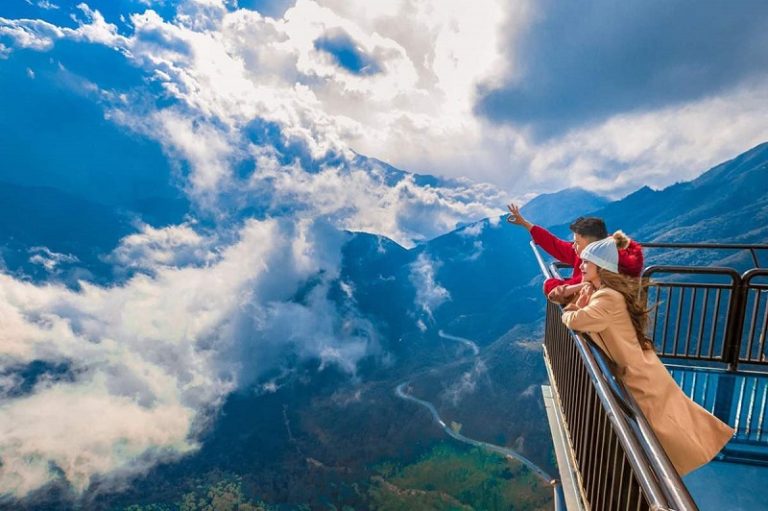Quick Guide to Bac Ha Market: A Textile Lover’s Paradise in Northern Vietnam
Capital of the Hmong Hoa (Flower Hmong), one of Vietnam’s most vibrant ethnic groups, Bac Ha District in Lao Cai Province, Northern Vietnam is a treat for the senses. Here are some guides to Bac Ha Market, which takes place once a week on Sunday morning, is one of the biggest and busiest in the region.
Women and men from Red and Black Dao, Nhung, Tay and Flower Hmong communities, all dressed in elaborate costume—their Sunday best, if you will—have been gathering here to trade for over a century. It’s a chance to stock up on fresh food, purchase clothing and textiles, and socialise and network with other members of the community. Many people travel long distances by foot or motorbike to attend.
The tourist appeal is a little different. Tourists flock to Bac Ha Market to catch a glimpse of the majestic costumes and buy authentic souvenirs. After sitting on my bucket list for many years, I finally had a chance to visit the market in July. In some ways, the market lived up to my high expectations; but there were some disappointments. This guide outlines practical visitor’s information plus considerations I think you should keep in mind when planning a visit to Bac Ha Market.

Is Bac Ha Market worth visiting?
From a tourist’s perspective, Ba Ha Market is a chance to get an intimate look at the culture and commerce of Northern Vietnam’s highlands. Visiting is definitely an exciting and interesting experience, but it’s not without its downsides. There are some very real concerns about over-tourism in Bac Ha and Sapa more generally. Some responsible tourism operators have gone so far as to discontinue their Bac Ha tours for fear of the negative impact they’re having on the community. I had to weigh them up before I decided to visit, and it’s something you’ll have to make a judgement call on for yourself.
There are other markets in more remote parts of Vietnam—particularly in Ha Giang—that are ‘more authentic’ and offer tourists a more rewarding experience (for now, at least). Part of Bac Ha’s appeal is its accessibility, which has turned out to be both a blessing and a curse.
All in all, if you’re in the Sapa area on a Sunday and you’re at all interested in textiles and ethnic culture, I would recommend visiting Bac Ha Market. With a little advance planning and smart decision making, you can visit Bac Ha without compromising on your ethics. I’ve tried to provide as many practical tips as I can throughout the post.

Is Bac Ha Market an ‘authentic’ experience?
I don’t think there’s any doubt that Bac Ha Market is romanticised and fetishised as an exotic cultural experience. Investors and tourism operators often see markets like Bac Ha as a money making opportunity, with little thought given to locals or cultural preservation. This quote from a popular travel booking website sums up the bizarre rhetoric that exists around Bac Ha.
Going to Bac Ha, tourists will meet the pure-minded face in colorful ethnic clothing. Along with their trading activities, the locals are also pleased with the fair, with all people in the market, including tourists. The drunk man unsteadily sitting on horseback and the woman leading their horse back to village are images remaining in the deepest way for tourists in minds when experiencing Sapa travel to the unique Bac Ha Market.
Mis-translations and grammar aside, you get the gist. Bac Ha is one of those places that’s sold to tourists in shiny brochures. It is commercialised, it is touristy, and it’s not authentic in the sense that it would be exactly the same even if tourists weren’t around. I’m not saying that’s a reason not to go to Bac Ha Market. I decided to go, but I was aware of what I was getting myself into and took everything with a grain of salt.

What to buy at Bac Ha Market
I subtitled this article ‘A Textile’s Paradise in Northern Vietnam’—and while I do believe that is the case, the textiles on offer at Bac Ha Market are a bit of a mixed bag. The eye candy factor is through the roof. The colours, patterns, brocade, batik, rolls of fabric and notions in their perfectly presented little bundles are just divine to look at and photograph. But on closer inspection, a lot of the stock looks cheap, badly made, and probably imported. Some stalls are stocked completely with machine-woven scarves, lacquer wear and other cheap, tacky souvenirs.
I’m no textile historian—I don’t pretend to have the knowledge or skills to be able to identify textiles or determine their authenticity—but with the limited knowledge I have, I could tell that not everything for sale at Bac Ha was exactly high quality.

There are two separate textile sections at Bac Ha Market. One one side, Hmong and Dao women sell silver jewellery and new costumes, which are very brightly coloured and made from acrylics. These are the products locals seem most interested in.
Products targeted at tourists, by contrast, include brocade, collars and cuffs, ankle wraps, head scarves and other wearable pieces. You’ll also see batik Hmong skirts(which weigh a tonne) and beautifully embroidered children’s hats. There are lots of blankets, wall hangings, trimmings and fabric remnants, which can be framed or repurposed into something new. (Tamay and Me, Future Traditions and Kilomet 109 are just some of the Hanoi-based fashion labels that incorporate ethnic textiles into new clothing designs).
If you poke around you’ll find other cute souvenirs too, including old buffalo bells. I was tempted to buy a few and make a wind chime out of them.

Being a responsible traveller in Bac Ha
Sapa’s troubles with overtourism and the negative social and environmental effects of hosting visitors are well documented. Don’t be part of the problem. There are two ethical concerns to keep in mind when visiting Bac Ha Market: Firstly, where is your money really going? And secondly, photography.
The two photos above are good examples of the kind of photos you probably shouldn’t take at Bac Ha Market. Sticking a camera lens into someone’s face when they’re trying to do their shopping or eat their breakfast isn’t very nice. Ethnic minority people (women in particular) are generally quite modest and camera shy. A few people visibly recoiled from the camera when they spotted me trying to snap a photo. (I’m usually horrified when this happens and wouldn’t dream of photographing anyone who is obviously uncomfortable with having their picture taken). Any photos you see of people here were taken stealthily.
Questions of local ownership and profits from the market should also be kept in mind. In the past, Bac Ha was a place where independent vendors could meet and trade wares, a good share of which were probably made or grown or raised by hand. That doesn’t appear to be the case anymore. I have it on good authority that Bac Ha Market has changed dramatically over the past few years. New stallholders have come in (mostly Kinh Vietnamese) and flooded the market with huge quantities of textiles that are questionable in quality and origin. Meanwhile Hmong and Dao traders—who sell the ‘less appealing’ new, synthetic costumes—appear to have been relegated to the back of the market.
Bac Ha Market: Visitor’s Guide
Thinking of visiting Bac Ha Market? Here’s everything you need to know before you go.
Bac Ha Market opening hours
Bac Ha Market is a weekly market that only takes place on Sundays. As with all local markets in Vietnam, the earlier you arrive the better. The market is much more atmospheric in the early morning and winds down dramatically by 10am. To see Bac Ha at it’s liveliest, it would be wise to stay Saturday night at a hotel in town and get up early the next day. We arrived at Bac Ha at around 11am and things were already quietening down for lunch.
Earlier this year, I inquired about visiting Bac Ha Market just after Tet (Vietnamese New Year) in February, and was warned that the market wouldn’t be on. If you’re travelling to Bac Ha during Tet or another Vietnamese holiday, best to check ahead before you plan your visit to the market.

Orientation & what to see
I have to preface this with a disclaimer: I’m not even sure I saw the whole market! Let me explain.
I travelled to Bac Ha by myself. This was my first solo trip within Vietnam, and my first time travelling without Ross in over a year. I was anxious—I’m not afraid to admit that. Bac Ha had been on my bucket list for years and I certainly enjoyed my time there, but it wasn’t a carefree trip.
I have a terrible sense of direction and get lost easily. Very easily. Ross is the navigator and I usually rely on him to get me where I want to go and more importantly, get me back. Because I was with a group, I had a set time to rendezvous at the bus, which was parked a little way away from the market entrance. I was a little bit paranoid about getting disorientated and not being able to get back to the bus—so as a result, I stuck to the main roads and didn’t go as ‘deep’ into the market as I might have had I been with Ross.
The parts of Bac Ha I did see were exactly what I’d been told to expect, so I’m assuming I hit most of the main spots. There’s no ‘main entrance’ to the market, mostly because it’s outdoors. As you walk down the road into the heart of the market, there are stalls spread out on either side. On the right, I walked through mainly makeshift stalls covered with tarpaulin, where women in vibrant Hmong dress sell new costumes, mostly made from synthetics.
On the left, I descended to a lower level of the market. The stalls in this area were different, mainly selling antique textiles and staffed by men and women in Western clothes. This is the part of the market that appeals most to tourists and where most Westerns appeared to be buying things. Further back still I found a large outdoor produce section, with vendors set up under umbrellas. This led into an undercover produce market. It was so pungent, I didn’t spend much time in this area. I also wandered through a dining area with lots of food stalls and undercover seating.
Bac Ha Market is pretty easy to navigate on your own, and you’ll have no trouble discovering these different parts of the market for yourself. The layout is pretty intuitive and it would be difficult to get lost given the main road that runs through the centre. Google Maps works perfectly—if you have to meet your group somewhere outside the market like I did, it might be worth dropping a pin so you can find your way back more easily.

What to wear & bring with you
The climate in Bac Ha (much like Sapa) is very different from in Lao Cai. Because of the elevation, mist and rain are common. It can also get quite cold (even in the middle of summer) so it’s pretty much essential to carry a jacket or scarf with you.
Bac Ha Market is an all-weather event—rain, snow or shine. As you can tell from some of my photos, the day I visited was pretty miserable, with periodic downpours throughout the morning. I was glad to be wearing a rain jacket and to have my umbrella with me.
I thought I was doing the right thing by wearing my ‘sensible’ sneakers to Bac Ha. Honestly, I wish I had worn sandals like everyone else. There’s not that much walking involved, and plastic shoes are far easier to clean off at the end of the day (the market is pretty gnarly and you’re bound to step in squashed fruit or worse). There’s no dress code for Bac Ha; but since you’re in rural Vietnam, I highly recommend both women and men dress modestly (covered knees and shoulders).
If you plan on doing some shopping, carry some small notes (100K and 50K VND) with you. Stallholders will always have change, but I find it’s easier to pay with the correct money if you can. Bring a tote or fold-up bag with you to carry your haul—say no to plastic.
I carried my money, phone and passport around in my backpack. No one at the market was overly aggressive (a few women were very hands on and one woman did tug my arm a bit too hard), and I doubt that pick-pocketing is a common occurrence. Similarly, I felt comfortable enough to have my camera out the whole time.
There are food stalls inside the market (serving mainly horse stew), and a few restaurants on the main street. Inside the undercover part of the market, there’s also a big western-style cafe. Along the edges of the market and in the fresh produce section you’ll notice ladies frying balls of dough. These are delicious ‘donuts’, some stuffed with sweet corn. For 2K VND each, they make a great market snack.

How to get to Bac Ha Market
By bus from Sapa | Bac Ha Market lies 100km (62 miles) east of Sapa. The long drive over unkempt, windy roads takes the better part of three hours by minivan—I expect it would take around 4 hours by bus. There are direct local buses from Sapa to Bac Ha, but I recommend changing buses at Lao Cai for a more reliable journey. Minivans bound for Lao Cai city depart from Sapa’s main square throughout the day. A ticket costs 30K VND.
By bus from Lao Cai | In Lao Cai city, find your way to the main bus terminal and pick up a Bac Ha-bound bus. According to this schedule, buses depart at 6am, 11am and 1pm. A ticket costs 70K VND.
By private transport | Any travel agency in Sapa can organise van transfer to and from Bac Ha. This is essentially what I did with Sapa O’Chau. I was part of a big group, and a ticket cost me 15 USD. Note that this price DID NOT include a guide or lunch.
Expect to pay around 120 USD for a private car, driver and tour guide to take you to Bac Ha Market and back. This can also be organised through a local tour agency or via your hotel. Another option (if you’re feeling brave) is to hire a motorcycle and make your own way to Bac Ha Market. There are plenty of hire shops in Sapa. Expect to pay around 100K VND per day for an automatic motorbike.
Bac Ha Market day tours
The easiest way to visit Bac Ha Market is on a day tour from Sapa. There are a number of companies that organise package tours departing from Sapa town (via Lao Cai) every Sunday morning.
When I went to Bac Ha, I travelled with Sapa O’Chau. I chose them for two reasons: Firstly, they have a reputation for being champions of responsible tourism in the region (the company is owned by a Hmong woman); and secondly, a friend with a lot of experience recommended them. I wish I could give Sapa O’Chau a glowing review—but I honestly can’t. I had some major issues with Sapa O’Chau, both logistical and in terms of tourism ethics. I’m in the process of providing them with feedback, which they will hopefully take on board. I want to give them a chance to respond to my concerns before I say too much. If I see fit, I’ll write a separate post about it in the future.
As I mentioned earlier, Ethos has stopped offering organised day tours to Bac Ha. However you can still travel with them to the market as part of a customised tour. Sapa Sisters, another popular provider, also offer day trips to Bac Ha Market, apparently accompanied by a local guide. I haven’t travelled with Ethos or Sapa Sisters, so I can’t personally endorse them.

Other things to do in Bac Ha
Once you exit the market, there’s a small pagoda just outside which you can also visit. Wandering up and down Bac Ha’s main street is also nice—a few small produce stalls spill out onto the streets, and it’s interesting to see the rest of the town (although it does feel very touristy). Around Bac Ha, there are a number of small Hmong villages you can visit. Some Bac Ha Market group tours include a visit to one particular village on the way back to Lao Cai. I wasn’t a big fan—but I’ll save that for another post.
One thing I missed (and I’m very disappointed about it!) is the 1921-completed Hoang A Tuong mansion house. For some reason I thought it was a long way away from the market—but it’s only 800m up the road. I’m still kicking myself for not walking further as I would have loved to see it in the flesh. Do check it out if you have time.

Where to stay in Sapa
Most people head back to Sapa after Bac Ha Market (although it is possible to get dropped off in Lao Cai in time for an afternoon bus or the night train). In Sapa town, I highly recommend Sapa Unique Hotel, which has fantastic views over the valley. I stayed here after my Bac Ha experience and thought it was the perfect place to unwind after a huge day of bus travel. In Ta Van Village, just outside Sapa, check out Indigo Snail, an authentic Hmong homestay managed by Sue and her family.





















